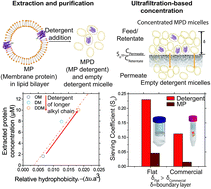Improving extraction and post-purification concentration of membrane proteins†
Abstract
Membrane proteins (MPs), despite being critically important drug targets for the pharmaceutical industry, are difficult to study due to challenges in obtaining high yields of functional protein. Most current extraction efforts use specialized non-ionic detergents to solubilize and stabilize MPs, with MPs being concentrated by ultrafiltration (UF). However, many detergents are retained during the UF step, which can destabilize MPs and/or interfere with their characterization. Here, we studied the influence of detergent selection on the extraction and UF-based concentration of biomedically-relevant MPs, the light-driven sodium and chloride transporters, KR2 and halorhodopsin (pHR) which are also model proteins for more complex mammalian rhodopsins. We also designed a flat-bottomed centrifugal filter that can concentrate MPs with enhanced removal of free detergents by promoting concentration polarization (CP). We tested the performance of this new filter using four commonly employed MP detergents, octyl-β-D maltoside (OM), decyl-β-D maltoside (DM), dodecyl-β-D maltoside (DDM) and octyl-β-D glucoside (OG), over a range of detergent and salt concentrations. Detergent passage is significantly higher for the flat-bottomed filter achieving up to 2-fold greater sieving of detergent in DM-solubilized pHR system due to the high degree of CP. We observe more efficient, up to 5-fold higher extraction of KR2 in the presence of a longer 12-carbon alkyl chain detergent, DDM compared to a shorter 8-carbon detergent, OM. Assuming complete binding and elution of the extracted protein, DDM-based extraction of KR2 could lead to a potential 7-fold improvement in purification yields compared to conventional methods which yield ∼1 mg MP per liter of cell culture. However, the longer chain detergents like DDM form larger micelles that are difficult to remove by UF. Thus, there exists a trade-off between choosing a detergent that will enable efficient extraction of MP while showing easier removal during subsequent UF. The extraction efficiency and UF-based separation of detergent micelles provide insights for other applications involving detergent–mediated separation/extraction.



 Please wait while we load your content...
Please wait while we load your content...